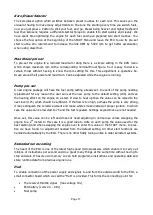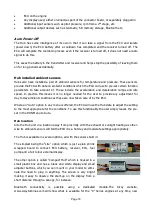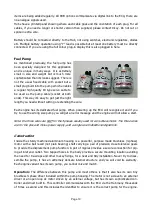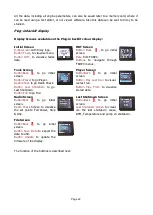
Page 14
Installation Notes
1.
The engine should be mounted securely using only the strap mount supplied.
2.
The 3-wire connecting cable from the engine to the connector board should be carefully
routed away from the engine intake so there is no possibility of the wire being accidentally ingest-
ed if the FOD screen should be displaced for any reason. Avoid placing the cable close to the en-
gine rpm sensor which is located at approximately 4 O´clock when viewed at the front of the en-
gine with the cable entry plug at 12 O´clock. A cable too close can cause some rpm interference at
start-up. The same goes for any servo wires passing near.
3.
The 4mm fuel feed pipe should be routed similarly clear of the intake.
4.
The other end of the engine cable should plug into the Hub sited at a convenient location
for access. This is also the location to connect the ECU battery. If battery is sited at some distance
perhaps in the nose of the aircraft, please contact Xicoy and ask for a longer cable in one piece.
Please don´t cut it and splice in a couple of old bits of wire to make it longer. A heavy duty exten-
sion can be used but check polarity before plugging in. It’s always better to have a longer single
piece cable for minimum volt drop and maximum reliability.
5.
The centre of the fuel tank should be located as close to the centre of gravity (CofG) of the
model as possible. This will minimize the effects of the CofG shifting as the fuel is used during the
flight. The fuel tank should have an effective fuel pickup, like a felt clunk or felt bag over a
weighted clunk to ensure no air is pulled into the fuel feed.
6.
The fuel pump should be located close to the fuel tank as convenient. Fit the inline filter
between tank and pump to protect the pump from particles that could jam the pump. The pump
has two screw fixings provided for mounting to the airframe.
7.
If using “Tygon” flexible piping from fuel tank push on a short (12mm/1/2”) length of the
supplied 4mm pipe onto the pump suction port and push the “Tygon” over the top to provide a
tight leak free fitting. A double wrap of lock-wire will ensure secure connection. Otherwise, use the
4mm piping supplied. The X120 engine has a larger 4mm nipple so requires a larger diameter fuel
inlet pipe.
DO NOT use nylon tie wraps anywhere on the fuel system.
8.
DO NOT use “Tygon” flexible piping anywhere for the pressure (delivery) side; it is only
suitable on the suction side. Also
DO NOT
use silicon tube anywhere in the fuel system as the fuel
will melt it.
9.
Any air ducting to the engine inlet should have sufficient diameter of at least the engine
case diameter.















































